How to recognize scams like New Policy Notice phishing scam
Phishing/ScamAlso Known As: New Policy Notice phishing email
Get free scan and check if your device is infected.
Remove it nowTo use full-featured product, you have to purchase a license for Combo Cleaner. Seven days free trial available. Combo Cleaner is owned and operated by RCS LT, the parent company of PCRisk.com.
What is "New Policy Notice" email scam?
After examining this email, we concluded that it is a phishing email used to trick recipients into providing their email account login credentials. It is disguised as a letter from an email service provider regarding some new policy. It contains a website link designed to open a deceptive page.
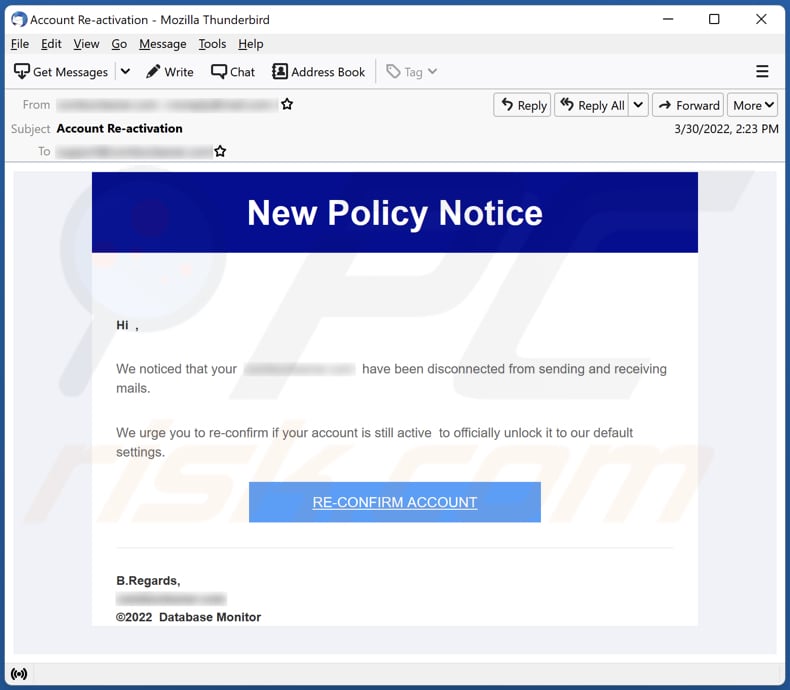
More about "New Policy Notice" email scam
This email claims that an email account has been disconnected from sending and receiving emails. It urges recipients to confirm whether their accounts are still active to unlock their default settings. Scammers behind this email attempt to trick recipients into opening a fake Webmail via the "RE-CONFIRM ACCOUNT" hyperlink and providing their password.
Stolen email accounts could be used to spread this scam further or send other phishing emails or even emails containing malicious attachments or links. Also, they could access emails containing sensitive information that may be used to hijack other accounts, steal identities, and other purposes. Accounts with the same password as the provided one could be stolen too.
| Name | New Policy Notice Email Scam |
| Threat Type | Phishing, Scam, Social Engineering, Fraud |
| Fake Claim | Email account is blocked from sending and receiving emails |
| Disguise | Letter from email service provider |
| Symptoms | Unauthorized online purchases, changed online account passwords, identity theft, illegal access of the computer. |
| Distribution methods | Deceptive emails, rogue online pop-up ads, search engine poisoning techniques, misspelled domains. |
| Damage | Loss of sensitive private information, monetary loss, identity theft. |
| Malware Removal (Windows) |
To eliminate possible malware infections, scan your computer with legitimate antivirus software. Our security researchers recommend using Combo Cleaner. Download Combo CleanerTo use full-featured product, you have to purchase a license for Combo Cleaner. 7 days free trial available. Combo Cleaner is owned and operated by RCS LT, the parent company of PCRisk.com. |
Phishing emails in general
As a rule, phishing emails are used to steal credit card details, social security numbers, login credentials, and other sensitive information. They are disguised as official/important letters from legitimate entities (for example, banks, service providers). Email can also be used as a tool to deliver malware.
Examples of phishing emails are "Ministerio De Sanidad Email Scam", "Your Account Will Be Suspended In 48hrs Email Scam", "NAVY FEDERAL CREDIT UNION Email Scam".
How do spam campaigns infect computers?
Cybercriminals behind emails used to deliver malware attempt to trick recipients into executing a malicious attachment or a file downloaded via a website link. They use malicious MS Office, PDF documents, JavaScript files, archives (like ZIP, RAR), executables, and other files to distribute malware. Their emails usually are disguised as official letters from legitimate entities too.
How to avoid installation of malware?
Do not open attachments and links presented in irrelevant emails sent from unknown addresses. Opening files downloaded from or through such emails can cause computer infections. Also, download programs (and files) from official websites. Do not trust files and programs downloaded using P2P networks, unofficial pages, third-party downloaders, etc.
Keep the operating system and installed programs up to date. Activate and update them with tools/functions provided by their official developers. If you've already opened malicious attachments, we recommend running a scan with Combo Cleaner Antivirus for Windows to automatically eliminate infiltrated malware.
Text presented in the "New Policy Notice email scam" email letter:
Subject: Account Re-activation
New Policy Notice
Hi,
We noticed that your - have been disconnected from sending and receiving mails.
We urge you to re-confirm if your account is still active to officially unlock it to our default settings.
RE-CONFIRM ACCOUNT
B.Regards,
-
©2022 Database Monitor
Screenshot of the fake Webmail page asking to provide login credentials:
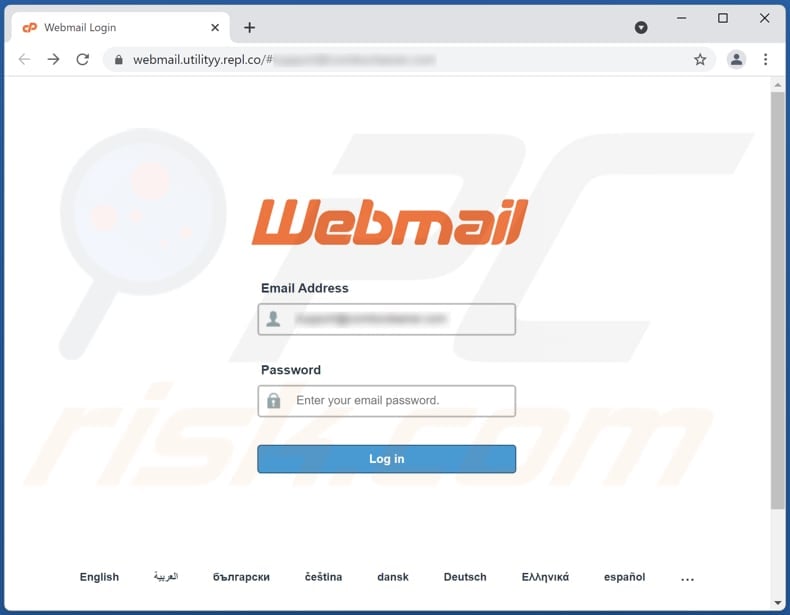
Another appearance of an email from this spam campaign:
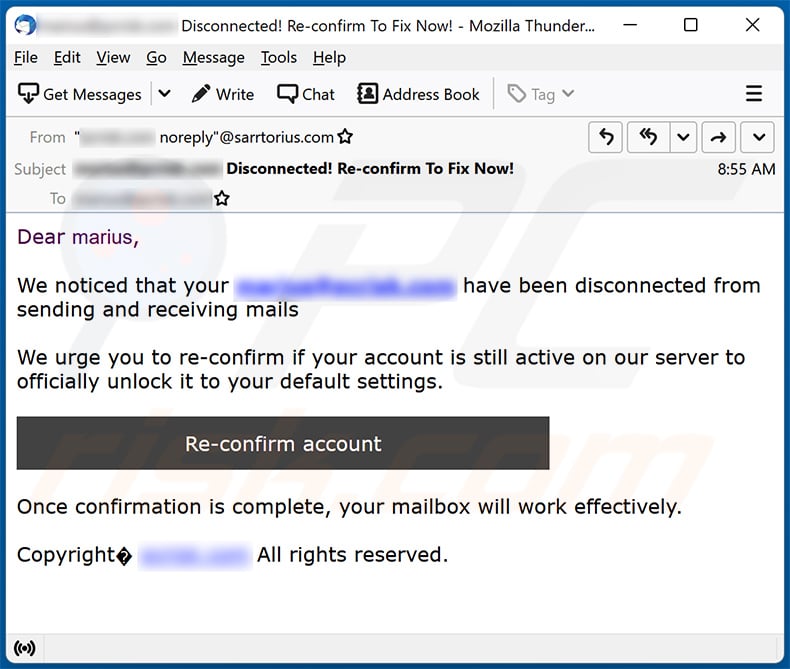
Text presented within:
Subject: ******** Disconnected! Re-confirm To Fix Now!
Dear ********,
We noticed that your ******** have been disconnected from sending and receiving mails
We urge you to re-confirm if your account is still active on our server to officially unlock it to your default settings.
Re-confirm account
Once confirmation is complete, your mailbox will work effectively.
Copyright ******** All rights reserved.
Screenshot of the promoted phishing site:
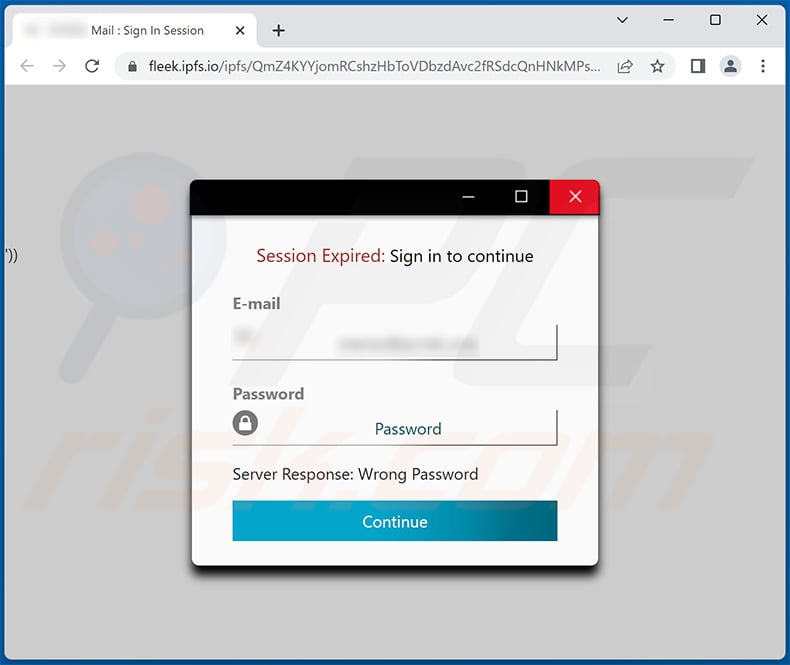
Another example of an email from "New Policy" spam campaign:
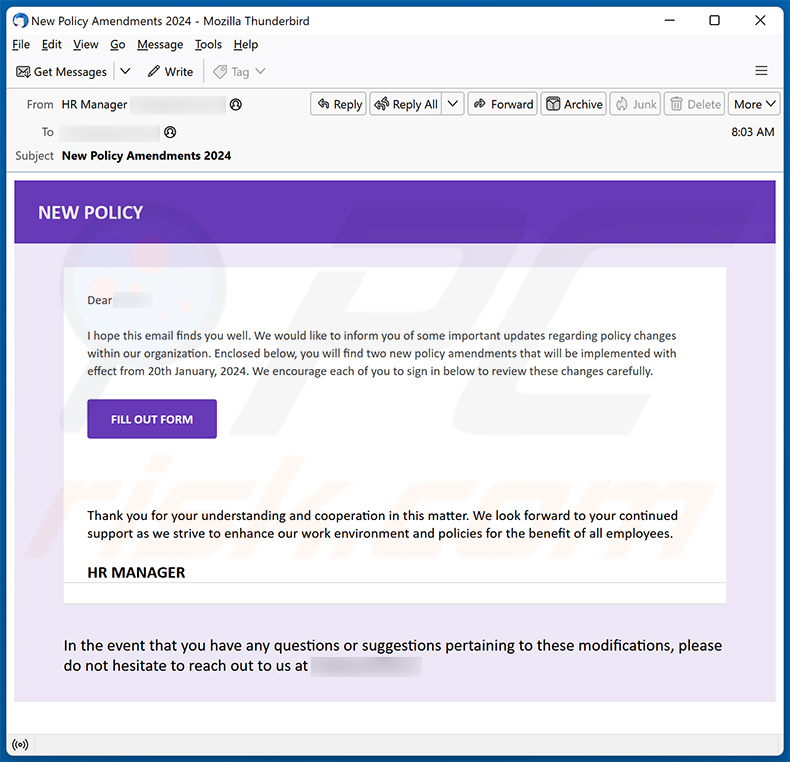
Text presented within:
Subject: New Policy Amendments 2024
NEW POLICY
Dear ********,I hope this email finds you well. We would like to inform you of some important updates regarding policy changes within our organization. Enclosed below, you will find two new policy amendments that will be implemented with effect from 20th January, 2024. We encourage each of you to sign in below to review these changes carefully.
FILL OUT FORMThank you for your understanding and cooperation in this matter. We look forward to your continued support as we strive to enhance our work environment and policies for the benefit of all employees.
HR MANAGER
In the event that you have any questions or suggestions pertaining to these modifications, please do not hesitate to reach out to us at ********
Screenshot of the promoted phishing site:
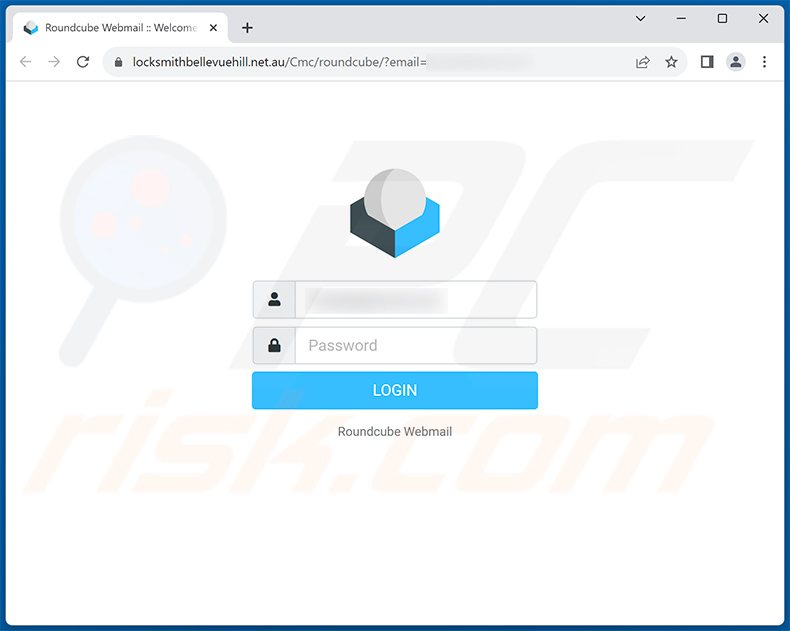
Instant automatic malware removal:
Manual threat removal might be a lengthy and complicated process that requires advanced IT skills. Combo Cleaner is a professional automatic malware removal tool that is recommended to get rid of malware. Download it by clicking the button below:
DOWNLOAD Combo CleanerBy downloading any software listed on this website you agree to our Privacy Policy and Terms of Use. To use full-featured product, you have to purchase a license for Combo Cleaner. 7 days free trial available. Combo Cleaner is owned and operated by RCS LT, the parent company of PCRisk.com.
Quick menu:
- What is New Policy Notice phishing email?
- Types of malicious emails.
- How to spot a malicious email?
- What to do if you fell for an email scam?
Types of malicious emails:
![]() Phishing Emails
Phishing Emails
Most commonly, cybercriminals use deceptive emails to trick Internet users into giving away their sensitive private information, for example, login information for various online services, email accounts, or online banking information.
Such attacks are called phishing. In a phishing attack, cybercriminals usually send an email message with some popular service logo (for example, Microsoft, DHL, Amazon, Netflix), create urgency (wrong shipping address, expired password, etc.), and place a link which they hope their potential victims will click on.
After clicking the link presented in such email message, victims are redirected to a fake website that looks identical or extremely similar to the original one. Victims are then asked to enter their password, credit card details, or some other information that gets stolen by cybercriminals.
![]() Emails with Malicious Attachments
Emails with Malicious Attachments
Another popular attack vector is email spam with malicious attachments that infect users' computers with malware. Malicious attachments usually carry trojans that are capable of stealing passwords, banking information, and other sensitive information.
In such attacks, cybercriminals' main goal is to trick their potential victims into opening an infected email attachment. To achieve this goal, email messages usually talk about recently received invoices, faxes, or voice messages.
If a potential victim falls for the lure and opens the attachment, their computers get infected, and cybercriminals can collect a lot of sensitive information.
While it's a more complicated method to steal personal information (spam filters and antivirus programs usually detect such attempts), if successful, cybercriminals can get a much wider array of data and can collect information for a long period of time.
![]() Sextortion Emails
Sextortion Emails
This is a type of phishing. In this case, users receive an email claiming that a cybercriminal could access the webcam of the potential victim and has a video recording of one's masturbation.
To get rid of the video, victims are asked to pay a ransom (usually using Bitcoin or another cryptocurrency). Nevertheless, all of these claims are false - users who receive such emails should ignore and delete them.
How to spot a malicious email?
While cyber criminals try to make their lure emails look trustworthy, here are some things that you should look for when trying to spot a phishing email:
- Check the sender's ("from") email address: Hover your mouse over the "from" address and check if it's legitimate. For example, if you received an email from Microsoft, be sure to check if the email address is @microsoft.com and not something suspicious like @m1crosoft.com, @microsfot.com, @account-security-noreply.com, etc.
- Check for generic greetings: If the greeting in the email is "Dear user", "Dear @youremail.com", "Dear valued customer", this should raise suspiciousness. Most commonly, companies call you by your name. Lack of this information could signal a phishing attempt.
- Check the links in the email: Hover your mouse over the link presented in the email, if the link that appears seems suspicious, don't click it. For example, if you received an email from Microsoft and the link in the email shows that it will go to firebasestorage.googleapis.com/v0... you shouldn't trust it. It's best not to click any links in the emails but to visit the company website that sent you the email in the first place.
- Don't blindly trust email attachments: Most commonly, legitimate companies will ask you to log in to their website and to view any documents there; if you received an email with an attachment, it's a good idea to scan it with an antivirus application. Infected email attachments are a common attack vector used by cybercriminals.
To minimise the risk of opening phishing and malicious emails we recommend using Combo Cleaner Antivirus for Windows.
Example of a spam email:

What to do if you fell for an email scam?
- If you clicked on a link in a phishing email and entered your password - be sure to change your password as soon as possible. Usually, cybercriminals collect stolen credentials and then sell them to other groups that use them for malicious purposes. If you change your password in a timely manner, there's a chance that criminals won't have enough time to do any damage.
- If you entered your credit card information - contact your bank as soon as possible and explain the situation. There's a good chance that you will need to cancel your compromised credit card and get a new one.
- If you see any signs of identity theft - you should immediately contact the Federal Trade Commission. This institution will collect information about your situation and create a personal recovery plan.
- If you opened a malicious attachment - your computer is probably infected, you should scan it with a reputable antivirus application. For this purpose, we recommend using Combo Cleaner Antivirus for Windows.
- Help other Internet users - report phishing emails to Anti-Phishing Working Group, FBI’s Internet Crime Complaint Center, National Fraud Information Center and U.S. Department of Justice.
Frequently Asked Questions (FAQ)
Why did I receive this email?
Scammers send the same email to all addresses in their database. They do not target anyone in particular (their emails are not personal). Usually, they obtain email addresses after data breaches.
I have provided my personal information when tricked by this email, what should I do?
If you have opened the provided website and entered your password, we strongly advise you to change all passwords as soon as possible.
I have downloaded and opened a file attached to an email used to deliver malware, is my computer infected?
If the file was an executable, then most certainly yes. In other cases, it cannot happen unless certain additional steps are performed. For example, malicious MS Office documents cannot infect computers until macros commands are enabled.
I have read the email but didn't open the attachment, is my computer infected?
No, a computer cannot be infected by opening an email. It is safe to open emails without clicking or opening links or files in them.
Will Combo Cleaner remove malware infections that were present in email attachment?
Yes, Combo Cleaner can detect and remove almost all known malware. Infected computers should be scanned using a full scan. High-end malware can be hiding deep in the operating system. Thus, it cannot be detected without running a full scan.
Share:

Tomas Meskauskas
Expert security researcher, professional malware analyst
I am passionate about computer security and technology. I have an experience of over 10 years working in various companies related to computer technical issue solving and Internet security. I have been working as an author and editor for pcrisk.com since 2010. Follow me on Twitter and LinkedIn to stay informed about the latest online security threats.
PCrisk security portal is brought by a company RCS LT.
Joined forces of security researchers help educate computer users about the latest online security threats. More information about the company RCS LT.
Our malware removal guides are free. However, if you want to support us you can send us a donation.
DonatePCrisk security portal is brought by a company RCS LT.
Joined forces of security researchers help educate computer users about the latest online security threats. More information about the company RCS LT.
Our malware removal guides are free. However, if you want to support us you can send us a donation.
Donate
▼ Show Discussion